Seiichi Yoshida's Diary of Comet Observations (2007)
|
Japanese version Home page |
Updated on May 4, 2013 |
![]()
|
Go to Seiichi Yoshida's Diary of Comet Observations in 2008. |
![]()
|
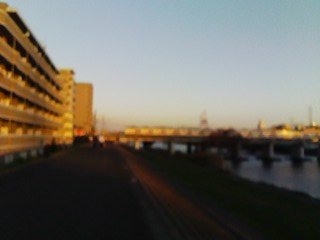 |
I observed 8P/Tuttle and 17P/Holmes on Dec. 30 and 31 beside Tsurumi River in Yokohama City, Kanagawa, Japan.
Dec. 31, the last night of 2007, was very cold with a strong wind. But the sky was clear and I could see two comets in a large city Yokohama. The weather was fine also on Dec. 30, but the sky was hazy.
New year 2008 will be soon. I wish you a happy new year!
8P/Tuttle
Dec. 31 5.7 mag Dia. 15' DC 3-4 (10x66 monocular 10x)
Unexpectedly, moderately condensed. It was near by a bright galaxy M33, within the same field of view. M33 was a very hard object due to the light pullution. But I managed to catch the faint diffuse galaxy and see the rendezvous.
17P/Holmes
Dec. 30 3.8 mag Dia. about 55' DC 0 (10x66 monocular 10x)
Dec. 31 3.8 mag Dia. about 60' DC 1 (10x66 monocular 10x)
Extremely diffuse. Uncertain how large the comet's coma extends due to the light pollution. I only managed to see the faint nebulous something around the position on Dec. 30 in the hazy sky. On Dec. 31 in the clear sky, the central bright part was clearly visible, extending elliptically.
|
|
|
 |
I observed 13 comets and Phaethon visually on Dec. 8 and 9 in Kita-karuizawa, Gunma, Japan.
Mt. Asama has been already covered with snow and looks beautiful.
Now we have many visual comets. That's our pleasure. But it takes long time to observe all of them, and make a report of them.
The weather changed sometimes during one night on Dec. 8. Clouds covered frequently. However, I could have an amazing excellent clear sky when clouds went away. Easy to see faint stars in the very dark sky.
Northern mountains were covered with heavy clouds, and sometimes the clouds came here. They were thunder clouds, and frequently the thunder flashed the ground intensely with no sound. I had light snow temporariry after midnight.
It was almost completely cloudy in the evening. I woke up too late in the morning. So I missed some comets in the evening and morning.
It was sunny in daytime on Dec. 9. But it became cloudy again in the evening, with light snow. Some time later the clouds started going away, so I observed comets while light snow was falling. The weather became fine soon, then it kept fine all night. Northern mountains were covered with heavy clouds, but no thunder this night.
This night was dry. My telescope or car was not frozen. The finder scope was not steamed up. So easy to observe comets. The sky was clear, however, not so excellent as the previous night.
Mars shines intensely. It is a large round ball through a telescope. Few dark spots are visible, so it is really dazzling.
I also tried to observe C/2007 B2 ( Skiff ), but I checked the wrong position.
The temperature was 0 degree to minus 2 degree on both nights.
C/2006 OF2 ( Broughton )
Dec. 9 fainter than 14.3 mag Dia. 0.4' (40.0-cm reflector 257x)
It must be coming closer to the sun. But it is getting fainter on and on. Now I could not see it, although it tried to catch it for about 20 minutes.
C/2006 Q1 ( McNaught )
Dec. 9 12.5 mag Dia. 0.8' DC 3-4 (40.0-cm reflector 144x)
Extremely low. I could observe it when it entered the gap of trees far away. The comet looks bright enough.
It was lucky that the clouds disappeared before the comet became highest.
Because the area is too low, background stars did not look sharp in focus.
C/2006 S5 ( Hill )
Dec. 8 14.0 mag Dia. 0.5' DC 4 (40.0-cm reflector 257x)
Dec. 9 14.1 mag Dia. 0.4' DC 4 (40.0-cm reflector 257x)
Fairly bright, clearly visible.
C/2006 W3 ( Christensen )
Dec. 8 14.5 mag Dia. 0.6' DC 4 (40.0-cm reflector 257x)
Dec. 9 14.3 mag Dia. 0.4' DC 5 (40.0-cm reflector 257x)
Unexpectedly bright. Easily visible on Dec. 8 with an excellent clear sky. It looks small on Dec. 9.
P/2007 H1 ( McNaught )
Dec. 8 13.4 mag Dia. 0.7' DC 3 (40.0-cm reflector 257x)
Dec. 9 14.0 mag Dia. 0.6' DC 3-4 (40.0-cm reflector 257x)
It became faint, but still easy to see.
8P/Tuttle
Dec. 8 8.4 mag Dia. 13' DC 3 (40.0-cm reflector 36x)
Dec. 8 8.1 mag Dia. 16' DC 2 (10x70 monocular)
Dec. 9 8.7 mag Dia. 9' DC 3-4 (40.0-cm reflector 36x)
Dec. 9 7.9 mag Dia. 10' DC 3 (10x70 monocular)
Very very large! I observe this comet for the first time since early November, and the comet became completely different during one month. It is also visible, bright and large, through a small monocular. Diffuse, but moderately condensed in the center.
17P/Holmes
Dec. 8 2.7 mag Dia. 67' DC D2 (naked eye)
Dec. 9 2.7 mag Dia. 70' DC D2 (naked eye)
Amazingly bright in the mountain location! Still 2-mag object, so it has been keeping completely the same brightness since the outburst in late October. Much brighter, and much more attractive than Double Cluster h and chi Persei.
It looks like a round planetary nebula with naked eyes. However, it also looks like a moderately condensed object (DC=4 or so) because so bright. So I do not feel it is a diffuse object. I want to estimate the brightness only with naked eyes because too bright. Because I am nearsighted, easy to estimate the total magnitude using Sidgwick method just waaring off my glasses.
It looks like a jellyfish, similar to the photos, through the 10x70 monocular.
The view through the 0.40-m telescope is fantastic, the transparent envelope covers the whole scope view. The rim of the envelope is very clear with such a high magnification.
The cometary nucleus is not visible through the 0.40-m telescope. Only the remnant of the outburst has been visible.
29P/Schwassmann-Wachmann 1
Dec. 8 14.0 mag Dia. 0.4' DC 2 (40.0-cm reflector 257x)
Dec. 9 14.5 mag Dia. 0.5' DC 2 (40.0-cm reflector 257x)
Faint but visible again. Diffuse.
46P/Wirtanen
Dec. 9 12.9 mag Dia. 1.2' DC 1-2 (40.0-cm reflector 144x)
Very diffuse. I observed it during light snow was falling, disturbed with clouds frequently.
50P/Arend
Dec. 8 15.0 mag Dia. 0.4' DC 3-4 (40.0-cm reflector 257x)
Dec. 9 fainter than 15.3 mag Dia. 0.3' (40.0-cm reflector 257x)
I could see it on Dec. 8 with an excellent clear sky. Very faint and small.
93P/Lovas 1
Dec. 8 12.8 mag Dia. 1.2' DC 4 (40.0-cm reflector 144x)
Dec. 9 13.1 mag Dia. 1.2' DC 6 (40.0-cm reflector 144x)
Moderately condensed, bright and easy to see. Enjoyable.
110P/Hartley 3
Dec. 9 14.4 mag Dia. 0.5' DC 4-5 (40.0-cm reflector 257x)
Moderately condensed.
191P/McNaught
Dec. 8 14.1 mag Dia. 0.5' DC 5 (40.0-cm reflector 257x)
Dec. 9 14.2 mag Dia. 0.6' DC 3 (40.0-cm reflector 257x)
Unexpectedly bright and clearly visible. I confirmed the motion during 3 hours on Dec. 8.
(3200) Phaethon
Dec. 8 13.4 mag DC 9 (40.0-cm reflector 257x)
Dec. 9 14.2 mag DC 9 (40.0-cm reflector 257x)
Very interesting! It moves very fast. I could see the motion clearly in real time. Like an artificial satellite. The object is bright, so enjoyable.
|
|
|
|
|
|
|
|
|
|
|
|
|
|
|
|
|
|
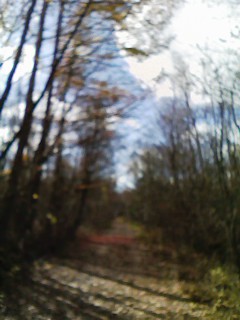 |
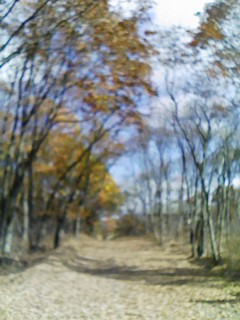 |
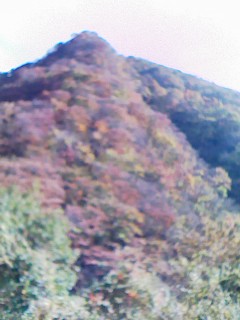 |
I observed 10 comets visually on Nov. 3 in Kita-karuizawa, Gunma, Japan.
The weather was fine with no clouds until midnight. So I really enjoyed Comet Holmes with a large telescope in a dark location. The climate is good now, so I also enjoyed autumn clusters and nebulae.
Comet Holmes through a 0.40-m telescope was really amazing and awesome! Not like a comet at all. I guess I can never see such an object again in my life.
It was fine in the evening, but hazy. The sky was not clear. At around 20:00 (local time), clouds came and covered low sky in the north-west and south-east directions. The sky overhead was fine until midnight. But clouds suddenly covered whole sky at midnight.
I also tried to see C/2007 T1. It located just below Jupiter. But a small cloud hid the area around 18:00 (local time), then the comet was hidden by Mt. Asama. So I could not observe it.
I also tried to observe 50P, but I watched the wrong position.
It was too late to enjoy red and yellow leaves in the mountains in Kita-Karuizawa. But mountains around Karasugawa Valley was so beautiful.
C/2006 OF2 ( Broughton )
13.9 mag Dia. 0.4' DC 3 (40.0-cm reflector 257x)
Difficult to see due to the hazy sky and a nearby 14-mag star.
C/2006 S5 ( Hill )
fainter than about 13.1 mag Dia. 0.5' (40.0-cm reflector 257x)
Not visible. Through thin clouds. Maybe disturbed by a nearby 14-mag star.
P/2007 H1 ( McNaught )
13.3 mag Dia. 0.5' DC 4 (40.0-cm reflector 144x)
Difficult to see due to the hazy sky. Maybe the comet became somewhat faint.
8P/Tuttle
13.1 mag Dia. 1.0' DC 1 (40.0-cm reflector 144x)
Already bright and large, as people reorted recently. Diffuse.
17P/Holmes
2.4 mag Dia. 36' DC D0 (10x70 monocular)
2.1 mag Dia. 20' DC 8 (naked eye)
Comet Holmes through a 0.40-m telescope looks a huge round disk. The rim of the northern half is sharp. On the other hand, the rim of the southern half is dim, melting into the background sky. So the impression is not a disk, but a jellyfish! The central bright core's diameter is quarter of the disk. A faint stellar nucleus located at the northern edge of the central core. The disk is flat with no structures even in the high magnification. The disk is gray with no transparency, so it looks like a smoke.
Through a 10x70 monocular in the dark location, the total disk coma, not only the central core, looks very bright. The coma looks flat, completely round, so it really looks like a disk. The outer faint gas coma is also clearly visible. The gas coma extends larger than Moon, the diameter is 36 arcmin. The bright dust disk is also getting larger, the diameter is 15 arcmin now.
With naked eyes, it looks cometary with strong condensation. It looks very bright in the dark location.
29P/Schwassmann-Wachmann 1
14.2 mag Dia. 0.6' DC 2 (40.0-cm reflector 257x)
No outburst has been reported recently. But it was visible unexpectedly. Diffuse, but not so extremely faint.
46P/Wirtanen
13.7 mag Dia. 0.7' DC 4 (40.0-cm reflector 257x)
Unexpectedly, it was already bright and large. Clearly visible even in the somewhat low sky.
93P/Lovas 1
13.6 mag Dia. 0.8' DC 5 (40.0-cm reflector 144x)
Very bright and easy to see, probably because it located overhead.
110P/Hartley 3
fainter than about 13.0 mag Dia. 0.3' (40.0-cm reflector 257x)
Not visible. Through thin clouds.
188P/LINEAR-Mueller
fainter than 14.3 mag Dia. 0.3' (40.0-cm reflector 257x)
Not visible. Maybe too close to a 11-mag star.
|
|
 |
I observed 17P/Holmes on Oct. 29 in Fujishiro, Toride City, Ibaraki, Japan; and Oct. 30 beside Tsurumi River in Yokohama City, Kanagawa, Japan.
Clear fine night on Oct. 29. I could see much fainter stars in the suburbs than the large city Yokohama. Comet Holmes was bright, nearly equal to Algol. It looked almost stellar with naked eyes, but I could see the faint halo around the stellar nucleus. But the comet did not look disk-like object with naked eyes.
Comet Holmes looked like an eye through a monocular, tiny central bright core and outer fainter round coma. It looked like a typical planetary nebula.
The condition was bad on Oct. 30. The sky was very hazy. The weather forecast said it will be rainy late at night, but I could see stars still in the evening. I observed the comet for 20 minutes. But the sky was covered with clouds 20 minuets after I went back home. The comet became larger.
It has passed one week since the outburst. Unexpectedly, Comet Holmes has kept bright at 2.5 mag for one week, while it has been getting larger and larger day by day through a monocular.
I can see Comet Holmes is moving in Perseus with naked eyes. The triangle with alpha Per and delta Per has been changing.
17P/Holmes
Oct. 29 2.5 mag Dia. 6.5' DC d6 (10x66 monocular 10x)
Oct. 29 2.3 mag DC 8-9 (naked eye)
Oct. 30 2.5 mag Dia. 8' DC 6 (10x66 monocular 10x)
Oct. 30 2.6 mag DC 9 (naked eye)
|
 |
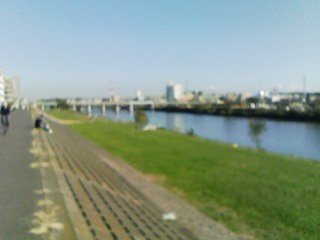 |
I observed 17P/Holmes on Oct. 28 beside Tsurumi River in Yokohama City, Kanagawa, Japan.
It was fine with no clouds all through the daytime today. The weather forecast says it will be cloudy, then rainy, tonight. Thin clouds came over the sky in the evening. But now clouds have gone, and the weather is fine.
17P/Holmes
2.4 mag Dia. 5' DC 6 (10x66 monocular 10x)
2.4 mag DC 9 (naked eye)
Comet 17P/Holmes looked flat last night, but it looks more cometary tonight. A tiny dense spot is visible at the center, surrounded with a circle coma. Now it is getting large, so the total magnitude seems to be getting slightly brighter.
It still looks stellar with naked eyes.
|
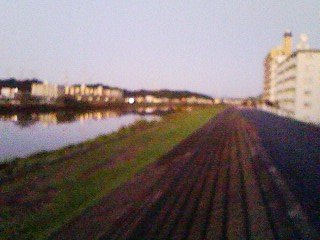 |
I observed 17P/Holmes on Oct. 27 beside Tsurumi River in Yokohama City, Kanagawa, Japan.
Typhoon has gone, and we could suddenly have a fine night as the weather forecast said. The sky is clear and stars are visible well, despite the full moon. I could finally see Comet 17P/Holmes since the outburst night.
17P/Holmes
2.7 mag Dia. 3.5' DC D2 (10x66 monocular 10x)
2.5 mag DC 9 (naked eye)
Comet 17P/Holmes still looks almost stellar with naked eyes. It is rather orange now. It got evidently brighter than Oct. 24. I could find the comet itself before recognizing the Perseus constellation.
Using a 10x66 monocular, I immediately found a strange round ball-like object, like a planetary nebula or an out-of-focus star. Now it is not sharp at all, although it was completely stellar and strongly sharp on Oct. 24. The color is similar to Jupiter or Saturn. But the rim of the comet is much more blurred than those planets. So it does not look like a planet.
|
|
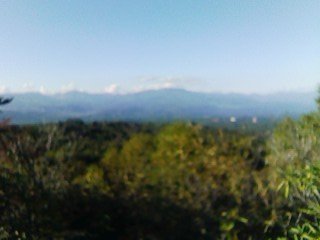 |
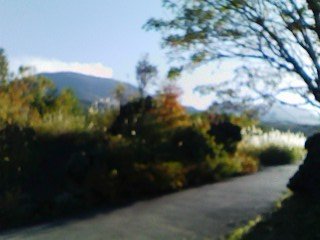 |
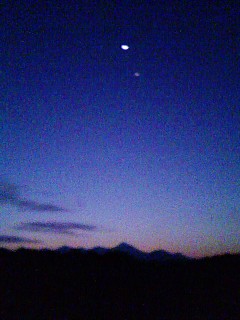 |
I observed 11 comets visually on Oct. 5 and 6 in Kita-karuizawa, Gunma, Japan.
The weather kept fine during my trip.
On Friday, it was cloudy in daytime. But as the weather forecast said, it became better rapidly after the sunset, and became fine at the end of evening glow. The sky was clear, probably due to the rain in the previous night. It kept fine all night, but Moon located in the morning sky.
On Saturday, it kept fine in daytime and we could see distant mountains clearly. It was also fine in the evening. But the lower sky was not as clear as Friday. Thin clouds came at midnight, but the sky around my target comets were not influenced so much.
In the morning sky, it was an excellent view to see the rendezvous of Moon, Venus, Saturn and Regulus. It was also nice to see the rendezvous of Mars and an open cluster M35. I could see many shooting stars.
The temperature was so high as 27 degrees in daytime in Tokyo, however, it was so cold as 3-4 degrees in the morning in Kita-karuizawa.
I also tried to observe C/2006 S5 ( Hill ), but failed because it was close to Moon, and the area was covered by thin clouds both nights.
C/2005 L3 ( McNaught )
Oct. 5 14.1 mag Dia. 0.3' DC 6 (40.0-cm reflector 257x)
Oct. 6 fainter than 13.9 mag Dia. 0.3' (40.0-cm reflector 257x)
I wondered if it became already too low to see. But I could see it. Very small, but strongly condensed and clearly visible. On Oct. 6, the sky became poor and I could not see the comet.
C/2006 OF2 ( Broughton )
Oct. 5 13.5 mag Dia. 0.6' DC 3-4 (40.0-cm reflector 257x)
Oct. 6 13.5 mag Dia. 0.5' DC 3-4 (40.0-cm reflector 257x)
Already bright and easy to see. Somewhat diffuse and dim. A 11.0 mag stationary satellite passed in the field at 19:00 JST on Oct. 6.
C/2007 F1 ( LONEOS )
Oct. 5 7.5 mag Dia. 3' DC 6-7 (40.0-cm reflector 36x)
Oct. 6 7.4 mag Dia. 4' DC 5 (40.0-cm reflector 36x)
Very bright!
Extremely low. I waited until it became high, and I observed it after the morning glow began. The comet looked very small, probably because the sky was already very bright.
I was surprised that it looked very strongly condensed and easy to see on Oct. 5. However, it was much harder to see on Oct. 6 than the previous day. So I wondered if the comet became diffuse and faded rapidly. But I guess it was due to the sky condition.
P/2007 H1 ( McNaught )
Oct. 5 12.6 mag Dia. 0.9' DC 6-7 (40.0-cm reflector 144x)
Oct. 6 13.0 mag Dia. 0.8' DC 6-7 (40.0-cm reflector 144x)
Very bright and easy to see. Significantly brighter than the other 13-14 mag comets on the same night. It looked similar to C/2003 WT42 in 2006, as it does on the CCD images.
8P/Tuttle
Oct. 5 fainter than 14.6 mag Dia. 0.4' (40.0-cm reflector 257x)
Oct. 6 fainter than 14.5 mag Dia. 0.3' (40.0-cm reflector 257x)
Not visible. Still too faint. On Oct 5, it located just between two 15 mag stars and I could fix the precise position, but nothing was visible. On Oct. 6, a nearby 15 mag star was visible clearly, but the comet was not visible. The ephemeris says it is already 14 mag, so I wonder when it brightens actually.
17P/Holmes
Oct. 5 fainter than 14.1 mag Dia. 0.4' (40.0-cm reflector 257x)
Oct. 6 fainter than 14.1 mag Dia. 0.4' (40.0-cm reflector 257x)
It was too late to observe, and not visible.
29P/Schwassmann-Wachmann 1
Oct. 5 14.1 mag Dia. 0.4' DC 4 (40.0-cm reflector 257x)
Not in outburst, but a small faint object was visible. Very different from the large diffuse looking after the outburst.
50P/Arend
Oct. 5 fainter than 14.2 mag Dia. 0.4' (40.0-cm reflector 257x)
Oct. 6 fainter than 14.3 mag Dia. 0.4' (40.0-cm reflector 257x)
I could see 15 mag stars, but the comet was not visible.
93P/Lovas 1
Oct. 5 13.4 mag Dia. 0.4' DC 5 (40.0-cm reflector 257x)
Oct. 6 13.4 mag Dia. 0.5' DC 5 (40.0-cm reflector 257x)
Already bright and easy to see. Moderately condensed and small.
110P/Hartley 3
Oct. 5 fainter than 14.4 mag Dia. 0.4' (40.0-cm reflector 257x)
It must be brightening rapidly now, so I hoped I could see. But actually , it was still too faint to see visually.
188P/LINEAR-Mueller
Oct. 5 fainter than 14.1 mag Dia. 0.3' (40.0-cm reflector 257x)
Oct. 6 14.4 mag Dia. 0.3' DC 4 (40.0-cm reflector 257x)
I tried to observe it, and unexpectedly I could see it. Extremely faint and small, near limit. So I spent much time to confirm whether it was really the comet. It was not visible on the previous night.
|
|
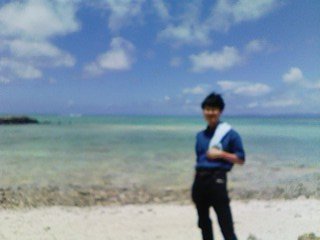 |
I observed C/2006 VZ13 visually on June 23 in Ishigaki-jima island, Okinawa, Japan.
I brought a monocular in my trip to Okinawa, and observed C/2006 VZ13. The comet was already bright enough to be clearly visible with a small monocular.
It was a tropical weather in Okinawa indeed. The sky was blue and clear. But I could see many white clouds here and there. The sky seemed humid, especially in the middle and low area.
I joined the public event at Ishigaki-jima Observatory, and enjoyed watching Venus, Saturn and Jupiter with a 1.05-m telescope. The view of Jupiter was especially spectacular and impressive. I could see the whirlpools in the bands easily. Best Jupiter in my life.
I could not see Southern Cross unfortunately, but I could see Alpha and Beta Centauri.
I met Tony Farkas in Naha on this trip, and had a lunch together. I was glad and happy to meet him, and to have talked on comet images, remote telescopes, comet survey, etc.
C/2006 VZ13 ( LINEAR )
9.4 mag Dia. 7.5' DC 5 (10x66 monocular)
I brought a monocular in my trip to Okinawa, and observed C/2006 VZ13. The comet was already bright enough to be clearly visible with a small monocular.
|
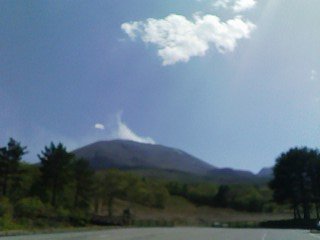 |
I observed 5 comets visually on May 26 in Kita-karuizawa, Gunma, Japan.
It was fine on Saturday and Sunday, and also all night without any clouds. But unfortunately, the sky condition was poor due to the yellow sands from China. And the half moon was shining in the evening.
I could not observe C/2006 VZ13 because it overlapped on a 14 mag star.
C/2005 L3 ( McNaught )
14.1 mag Dia. 0.3' DC 6 (40.0-cm reflector 257x)
It looked similar to a faint star, somewhat fainter than a nearby 14.6 mag star. Very tiny.
C/2006 WD4 ( Lemmon )
fainter than 12.2 mag Dia. 0.6' (40.0-cm reflector 257x)
I tried to catch it for 25 minutes, but failed.
The comet was predicted to fade out very quickly after it appeared in the evening sky. So this is the first and the last chance to observe it. I could have a fine sky without clouds in the low sky, but I could not see it due to the poor sky condition.
C/2007 E1 ( Garradd )
11.8 mag Dia. 1.5' DC 2 (40.0-cm reflector 144x)
Now it located low in the evening. But it is still bright.
It located near by Venus. I could not enjoy it for a long time because I had to move my telescope to C/2006 WD4 soon.
C/2007 E2 ( Lovejoy )
11.3 mag Dia. 2.7' DC 3 (40.0-cm reflector 75x)
It faded, but still enjoyable with a 40-cm telescope.
96P/Machholz 1
12.8 mag Dia. 0.8' DC 3 (40.0-cm reflector 144x)
It located a dense area of background stars. Faint diffuse nebulous object was visible among them. Unexpectedly, it seems still bright and visible visually.
|
|
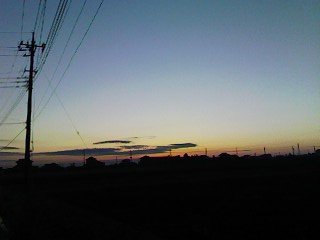 |
I observed Comet McNaught visually on Jan. 14 in Toride City, Ibaraki, Japan.
Today we could have another fine day. Although the sky was a bit hazy and not very clear, I could see Comet McNaught shining gold in the twilight at the sunset time.
A tiny cloud located around the horizon just at the sunset point, same as my last observation on Jan. 10. Sun was shining among the clouds at 16:30 (local time). The sunset was 16:48, but Sun was hidden by clouds at 16:35.
While searching with 10x70 monocular, I soon could find a bright comet with a tail, just over tiny gold clouds reflecting the evening light. It was 16:37, incredible, but Sun was still over the horizon. It was almost daytime. People were driving cars without switching the lights. However, Comet McNaught was very bright, shining like a planet, and easy to see.
Because I could find Comet McNaught, then I searched Venus in order to compare the brightness. However, I could not find Venus easily. Because it was before the sunset, probably Venus was still invisible. It means Comet McNaught has become really brighter than Venus.
I finally found Venus with 10x70 monocular at 16:42. Venus looked as bright as Comet McNaught when I found 5 minutes before. But this time, Comet McNaught was hidden by clouds and I could compare their brightness at the same time.
The sky was getting darker quickly. Venus became visible with naked eyes at 16:43, and getting brighter on and on.
Comet McNaught appeared again among low sky clouds at 16:44. Comet McNaught looked as bright as before. But Venus already looked brighter than Comet McNaught by 1 mag at that time, because locating higher.
Comet McNaught looked sharp sparkling stellar, same as my last observation on Jan. 10. But the tail direction has changed drastically during 4 days. Now the tail became wide and somewhat curving.
I could find Comet McNaught as a bright point-like star with my naked eyes at 16:47. But soon after that, Comet McNaught was hidden by clouds.
Comet McNaught had been visible for 10 minutes between 16:37 and 16:47. It was very fantastic and impressive to see bright comet shining among beautiful clouds reflecting evening light, whose color was changed from gold to madder red.
Using the winter extinction table, the brightness of Comet McNaught was estimated as -5.4 mag or brighter at 16:37, and as -4.9 mag at 16:44. So it was about -5.2 mag. What an incredible result!
By the way, many people reported it was easily visible in daytime. So I tried to search it around the eastern part of Sun at noon in the midst of Yokohama City. But I could not see the comet nor Venus.
I moved to Toride City, Ibaraki, and tried to search it again in daytime using 10x70 monocular. But I failed again. Maybe it was because Sun had been already getting lower at 15:30.
I myself have been found Venus in daytime with my naked eyes. But the sky was excellent, and Venus was far away from Sun enough. Today the sky was not very clear, so it was hard to find a comet very near by Sun in daytime.
But many people around me succeeded to catch the comet easily with binoculars...
C/2006 P1 ( McNaught )
about -5.2 mag DC 8-9 Tail about 0.2 deg (p.a. 65 deg) (10x70 monocular)
|
![]()
|
Go to Seiichi Yoshida's Diary of Comet Observations in 2006. |
![]()